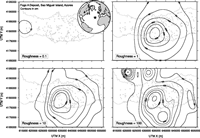An objective method for the production of isopach maps and implications for the estimation of tephra deposit volumes and their uncertainties
Engwell S. L., W. P. Aspinall and R. S. J. Sparks (17 June 2015).
Bulletin of Volcanology, Volume 77, Issue 7, doi:10.1007/s00445-015-0942-y.
Abstract
Characterization of explosive volcanic eruptive processes from interpretation of deposits is a key for assessing volcanic hazard and risk, particularly for infrequent large explosive eruptions and those whose deposits are transient in the geological record. While eruption size—determined by measurement and interpretation of tephra fall deposits—is of particular importance, uncertainties for such measurements and volume estimates are rarely presented. Here, tephra volume estimates are derived from isopach maps produced by modeling raw thickness data as cubic B-spline curves under tension. Isopachs are objectively determined in relation to original data and enable limitations in volume estimates from published maps to be investigated. The eruption volumes derived using spline isopachs differ from selected published estimates by 15–40 %, reflecting uncertainties in the volume estimation process. The formalized analysis enables identification of sources of uncertainty; eruptive volume uncertainties (>30 %) are much greater than thickness measurement uncertainties (~10 %). The number of measurements is a key factor in volume estimate uncertainty, regardless of method utilized for isopach production. Deposits processed using the cubic B-spline method are well described by 60 measurements distributed across each deposit; however, this figure is deposit and distribution dependent, increasing for geometrically complex deposits, such as those exhibiting bilobate dispersion.


